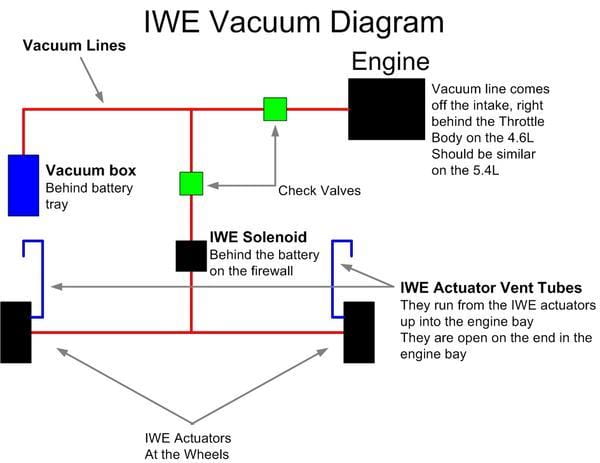For the uninitiated, it is important to understand what IWE is. Ford’s Integrated Wheel End (IWE) system locks and unlocks the front hubs from 2WD to 4WD. 4WD drive systems are typically designed for moderate to heavy off-road use. Vehicles with this system have a low range gearbox and manual or automatic transfer gearbox.
Vehicles with 4WD can often be distinguished by special attributes: higher ground clearance (on expensive versions of SUV it can be a height-adjustable suspension), good angles of cross-country ability, they are the same angles of entry at the front and exit – at the back, which allows you to climb and descend slopes and move over obstacles.
What is an IWE on a Ford 150?

Basically, IWE is Ford’s integrated wheel ends and the way they work is the following.
It’s actually three pieces:
- One piece is on the hub side and it’s a spline wheel, we’ll call it a gear.
- And there’s also an exact match spline wheel on the axle side. They don’t touch the piece that pulls it all together.
- The third piece is a ring that fits on the outside of them and can freely slide over them. When a slide or in place halfway over the axle and the hub side, it locks them in. When you have vacuum it pulls it over onto the hub side only and they’re free and that’s how it works.
So when your engine is not running and you park every time you turn off your engine, it is going to push the spline wheel this third piece over under the axle. So the front hubs are going to be locked in whether you’re in four-wheel drive or not when you turn the engine on and it draws vacuum. It sucks it over onto the hub side and puts it in all. It unlocks the wheel which is what you would want in two-wheel drive
Where is the IWE solenoid located?
Automatic transmission solenoid is a solenoid valve regulator that performs the work of closing and opening the oil channel. Its operation is controlled by an ECU, which sends continuous electrical impulses with a certain frequency. The solenoid controls the oil pressure on specific clutch bundles by quickly shifting gears or removing the hydraulic transformer lock. Transmission solenoid is responsible for the control of gearbox modes. The solenoid or solenoid valve is generally located in the hydraulic valve plate, the hydraulic block.
In the hydraulic block it is inserted into the channel, where it is fastened with a bolt or a special pressure plate. At the other end, it is connected to the control unit by means of a loop or wiring plug.
The actuator solenoid is responsible for the transmission of signals between the hydraulic and electrical systems. It connects them by means of its functions. And often, this integration causes faults that are detected by the computer. There are at least four solenoids in the automatic transmission unit. Their number depends on the complexity of the circuit and the number of steps. Cables and loops often cause solenoids to break, so they are replaced as quickly as the solenoid. IWE ones are located behind the battery on the firewall.
How do Ford vacuum hubs work?
The transmission “takes” the power from the motor and transmits it to the driving wheels through the shafts. If you’ve ever changed a wheel (which you probably have), you’ve probably seen that it’s not bolted directly to the shaft or axle. Thus, hub is the detail to which you screw the wheel. The wheel hub is the second part, hidden from your eyes, attached to the shaft. However, the design of the hub of the front wheel is a little more complicated than it seems at first sight.
The hub in a car should not simply duplicate the rotation of the shaft. Otherwise, manufacturers would not complicate the design and banal change its shape. It sits on the shaft body and is attached to its rotating part, transmitting its rotation to the wheels by means of ball bearings. This allows part of the load to be removed from the wheel during braking and acceleration.
The automatic hub lock that is installed on later Ford F-150 trucks is the IWE system. Like the CVH, the IWE is a single-solenoid vacuum blocker, but it works in the opposite direction. Vacuum pulls the hub up to 2WD, and the absence of vacuum outputs it to 4WD by default.
How do I know if my 4×4 is engaged?
To check the all-wheel drive, put one front wheel on the jack. Then rotate the front cardan by hand. Note that the raised wheel must also rotate. If the wheel is spinning, try to hold it by hand by simulating some of the road load. The wheel will stop and you will hear crunchy parts if the clutch components are faulty.
Check the second wheel drive in the same way. If there are any malfunctions, disassemble the clutch and inspect the All Wheel Drive Automatic Activation ring. If the ring breaks due to the wear, replace it without changing the clutch assembly. Check all-wheel drive visually. First turn the rudder to some side. Then you should take a close look at the inside. If a corrugated rubber-coated part enters the center of the wheel, this will indicate the front drive. Now take a look at the rear axle. You should go around the vehicle and look at the bottom. If there is a thickening in the middle of the beam or parts with the same rubber coating as the front wheel, this will indicate all-wheel drive.
Look at the 4WD light bulb – it should blink and light green when all-wheel drive is on. The light should not indicate a malfunction when the motor is off. Also, turn off the 4WD and position the car so that one wheel does not come into contact with the road (surface). Then turn on the four-wheel drive. This is not a difficult way to check the four-wheel drive.
















































Add comment